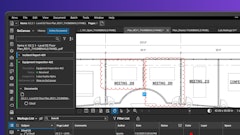
In our traditionally slow-to-adapt construction industry, many organizations are either unprepared for or overwhelmed by the magnitude of new and emerging technologies.
However, a 2018 report from FMI found that 55% of engineering and construction firms were “actively seeking new technology solutions” at that time, while also using technology to more strategically manage organizational risks in areas like resource allocation, productivity and efficiency and also safety. Yet Dodge Data & Analytics in its 2019 study, "Using Technology to Improve Risk Management in Construction," found that 90% of the contractors surveyed “do not specifically budget for innovation.”
This underinvestment, and let’s face it, lack of interest in technology, is responsible for the slow growth in productivity for our industry. To overcome that, we need to break out of our comfort zones and work towards adapting our workers to embrace these changes.
Once construction contractors are tuned in to the issues their companies face and are provided with effective solutions, there is no turning back. Contractors who aren’t interested in falling behind their competition know this and are continually seeking ways to get ahead. For those that aren’t there yet, here are ways to start:
1. Identify Inefficiencies
According to a report by McKinsey & Company, the productivity gap in construction costs the global economy $1.6 trillion annually. That’s number might feel huge and abstract, but the lack of productivity growth affects almost all construction companies and technology adoption will help us be better.
Construction business owners know that time is money and project overruns cost them both time and money. And since only 25 percent of construction projects are completed on time, the industry needs to investigate the reasons why overruns occur and find solutions.
Companies can use a variety of approaches and technology to identify areas where they are inefficient and focus on increasing productivity to reduce delays. For example, companies might put better processes in place for communication on jobsites, rethink their design or engineering processes and address labor shortages that often slow projects down.
While all those things can lead to productivity improvements, more advanced technology will continue to play a large role. The right tech and software solutions can make a huge difference in many aspects of a project.
2. Design Your Implementation Strategy
Once you identify inefficiencies, you may want to go all in on using technology to eliminate them, However, it's important not to let the pressure and need to boost productivity allow you to handle implementation poorly. It may be tempting to introduce several new programs as a means of cycling through technologies to find the right one, but taking commitment away from new technology integration can cause your entire process to fail. If you don't have a full program in place it will be difficult for employees to commit as well.
Keep in mind that technology doesn’t have to be all or nothing. Many platforms enable a layered approach to implementation, where the end user can be up and running very quickly. The best technology companies create plans that start with creating a platform that addresses the most painful challenges construction companies face. These are the inefficiencies you identified above. A good tech platform will then proceed with a staged implementation of features that continually build and will eventually allow for ongoing innovations in the field or office.
Companies that successfully implement technology first identify their existing system’s most significant deficiencies, and what’s not working with their current approach, and then layer the introduction of new technology over a period of three to nine months.
3. Make Sure to Have Employee Buy-In
The technology you purchase is only going to be as good as the employees that use it. User acceptance is always one of the most difficult challenges to overcome when implementing a new solution, despite the promised benefits and efficiency upgrades. Few people really like change, especially when it disrupts accepted, workable practices and accompanies any measure of downtime or new training procedures. Most users do not enjoy being forced to move from their comfort zones after years of trial and error with present systems.
Today, the most companies who see the highest rates of technology adoption at their company start with a bottom-up approach that engages day-to-day users and builds upon their experiences and insights to create operational shortcuts while fixing broken processes.
This starts with the development of a planning team that thoroughly understands organizational needs and generates company-wide excitement, while dealing with any concerns or disruptions along the way.
Finally, always offer continued training and education. You do not want employees learning something new and then not using the new system for months at a time. Conduct just-in-time training so employees are learning what they need to know, when they need to know it. Make sure your company is also conducting training refresher courses on new technologies and procedures so your employees always know what the latest advancements are that can make their job easier.
Technology implementation in the construction industry should not be painful, time-consuming and disruptive undertaking. Most of today’s applications readily merge with legacy systems to provide widespread information and instant access to accurate, up-to-date client, project and management information from a single, digitized location.



















